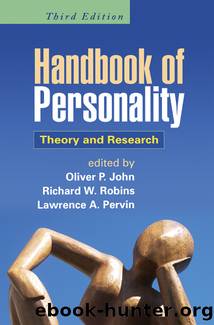Handbook of Personality : Theory and Research (9781606237380) by unknow

Author:unknow
Language: eng
Format: epub
ISBN: 978-1-60623-738-0
Publisher: Guilford Pubn
Published: 2008-01-15T00:00:00+00:00
Is the Self a Product of Evolution?
The eminent geneticist Theodosius Dobzhansky (1964) remarked that the self is the chief evolutionary novelty possessed by humans. Consistent with this view, behavioral genetic studies have documented the heritability of self-esteem and other self processes (e.g., Neiss et al., 2005, 2006). Evidence of heritability supports an evolutionary account of the self, but there are four possible interpretations. First, the self may be âgenetic junkâ; a characteristic that neither contributes to nor detracts from the organismâs fitness but is nonetheless passed on to succeeding generations. A second possibility is that the self is a functionless byproduct of another adaptation that does not solve any adaptive problems on its own but is carried along with the more functional characteristic. For example, the self has been described as an incidental by-product of high-level intelligence and complex sensory processing associated with large brains.
However, it is difficult to write off the self as an evolutionary accident or a functionless by-product. As much as any other component of the mind, the self fulfills the criteria of an adaptive design as outlined by Williams (1966): It is universal, complex, reliably developing, well-engineered, and reproduction promoting. Aspects of the self are clearly universal (i.e., species-typical); although there is individual variability in self-awareness and self-representations, all humans have both capacities. The self is also clearly complex, reliably developing, and, as we argue subsequently, promotes survival and reproduction.
Yet, even if we accept that the self meets the criteria of adaptive design, it may not be an adaptation in the technical sense of the word. Instead, the self may be an âexaptationââa feature that did not arise as an adaptation for its present use, but was subsequently co-opted for its current function (Gould, 1991); for example, a flyâs wings were originally selected for thermoregulation but were later used for flying. However, it seems unlikely that the self is an exaptation because the environmental features (e.g., complex social interaction) that likely created selection pressures for a self existed in our ancestral, as well as our current, environment.
Finally, the self may be a full-fledged adaptation that is part of our genetic programming. If self-related processes serve an adaptive function, then the mechanisms that underlie these processes should be hardwired into the brain. Thus, to the extent that researchers can identify neural mechanisms that seem to support highly specialized self-processes, this work provides further support for an evolutionary account. The strongest version of this account is that just as the brain has an evolved module governing language acquisition, it may also have a module governing aspects of the self such as self-awareness and self-deception (Pinker, 1997). A more moderate position is that people have a genetic blueprint for the basic parts of the self, but the self is assembled through interaction with the current environment. It is possible that we share with other great apes the same neurologically rudimentary self, but through language development and complex social interaction we simply do more with the raw materials. This position nicely integrates universalist and cultural relativist positions on the self.
Download
This site does not store any files on its server. We only index and link to content provided by other sites. Please contact the content providers to delete copyright contents if any and email us, we'll remove relevant links or contents immediately.
Application of a Novel Technique for Clinical Evaluation of Nitric Oxide-Induced Free Radical Reactions in ICU Patients by Unknown(696)
Rosenâs Emergency Medicine Concepts and Clinical Practice by Ron Walls; Robert Hockberger; Marianne Gausche-Hill; Timothy B. Erickson; Susan R. Wilcox(574)
Oxidative damage to surfactant protein D in pulmonary diseases by Vitality Starosta1 & Matthias Griese1†(410)
Social Science Perspectives on Global Public Health by Vincent La Placa & Julia Morgan(375)
Constructing Canine Consent; Conceptualising and Adopting a Consent-focused Relationship with Dogs by ERIN JONES(330)
Organic Chemistry: An Acid - Base Approach by MICHAEL SMITH(304)
ADVANCED EMERGENCY CARE AND TRANSPORTATION OF THE SICK AND INJURED by Unknown(272)
Saunders Nursing Drug Handbook 2024 - E-Book by Unknown(263)
Davis's Comprehensive Manual of Laboratory and Diagnostic Tests with Nursing Implications by Unknown(250)
Socio-Life Science and the COVID-19 Outbreak : Public Health and Public Policy by Makoto Yano; Fumihiko Matsuda; Anavaj Sakuntabhai; Shigeru Hirota(247)
Diagnostic and Statistical Manual of Mental Disorders, Fifth Edition, Text Revision (DSM-5-TR(tm)) by Unknown(246)
Human Microanatomy; Cell Tissue and Organ Histology with Celebrity Medical Histories by Stephen A. Stricker(245)
Berne and Levy Physiology E-Book by Unknown(237)
Replacing the Dead by Mie Nakachi;(232)
Handbook of Skin Disease Management by Jiyad Zainab;Flohr Carsten; & Carsten Flohr(229)
Access to Medicines and Vaccines in the South : Coherence of Rules and Policies Applied by the European Union Commission by Stephen Kingah(226)
Deep Learning and Medical Applications by Unknown(222)
The Pocket Guide to Sensorimotor Psychotherapy in Context (Norton Series on Interpersonal Neurobiology) by Pat Ogden(218)
Advances and Technical Standards in Neurosurgery by Unknown(215)
